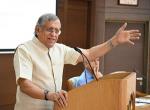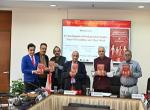‘Bangladesh Migrants - A Threat to India’ authored by P K Mishra, Senior Fellow of the Vivekananda International Foundation, was released at the VIF on 13 May 2014, by Shri Prakash Singh, IPS (Retd) and former Director General, BSF and a member of the advisory board of VIF. Lt General (Retd) Ravi Sawhney, chaired the session.
In his welcome address, Lt Gen Sawhney highlighted the problems faced by the country along its border with Bangladesh and the demographic changes noticed in border states and border districts besides in UP, Bihar, Delhi and various Bangladeshi pockets in most of the states from J&K upto Goa.
Recalling his stint at various border out posts along the Indo Bangladesh border starting from Sunderbans of West Bengal upto Tripura border, author P K Mishra described the demographic changes observed in various border belts and the vast government land and forests occupied by these migrants all along the border. He referred to the oppression of the Hindu minority in Bangladesh in 2012 at Coxs' Bazaar/ Chittagong including burning of Buddhist and Hindu temples, forcible conversions, molestation of Hindu girls, burning of thousands of Hindu houses and their villages in 2012, 2013 and in April 2014 and May 2014, which forced the community to seek refuge in India. Mishra also mentioned how about six lakhs of Bihari Muslims crossed the border and settled between Purnea in Bihar upto Islampur of West Bengal, on both sides of the national highway and close to Nepal and Bangladesh border.
Shri Mishra listed the porousness of the land border, existence of riverine border, gaps in the fencing, delay in fencing in Meghalaya, Tripura and Mizoram, delay in providing flood lights all along the fencing, under developed border areas, meagre amount of BADP and CAP funds from Centre for upgradation of border areas, want of border haats to sell local products, poor communication, health hazards, educational problems, power shortage, presence of number of enclaves in the other country, adverse possession land cases and delay in their ratification by Indian Parliament, menace of cattle smuggling, inflow of FICN and drugs, mushrooming of Mosques and madrassas all along the border, particularly in North 24 Paraganas, Nadia, Karimpur, Tehatta, Jalangi, Murshidabad, Dhubri, Silchar, Karimganj border areas, nexus between security/ politicians/ smugglers, nefarious design of ISI and DGFI, vote bank politics, increase in number of Muslim fundamental organisations in Assam and flexing of their muscles into Manipur/ Meghalaya and Tripura, ethnic Indian tribals becoming a minority, unauthorised sale of land to migrants, giving them voting rights/ ration cards and voters card, grabbing of employment/ educational vacancies by them and utilisation of PDS items and medicines meant for Indians by the migrant in fraudulent ways among the factors responsible for the problem and its economic impact on the country.
Shri E N Rammohan, ex DG BSF, narrated the problems faced by the Assamese people in their own state due to the entry of so many migrants from Bangladesh and the apathy of local government to push them back and the assistance rendered to the migrants by the state government over the years, allowing them to settle in Assam which was the prime cause of the unrest going on for years in Kokrajhar .
In his address, Shri Prakash Singh, stated that the biggest problem facing India and having a direct bearing on the country's economy and security is that of the continuing illegal migration of Bangladeshis into India. He said the factors encouraging the influx from Bangladesh side included steep rise in population with increased pressure on land, mounting un-employment, recurrence of natural disasters like floods, cyclones, better economic opportunity in India, religious persecution of Hindus, discrimination of tribals, Islamic interest in expanding territory, porous and easily negotiable international borders full of anti socials and touts.
During the question answer session that followed, Shri Ajit Doval, Director, VIF, drew attention to the various recommendations of the Group of Ministers on Border Management issues.





